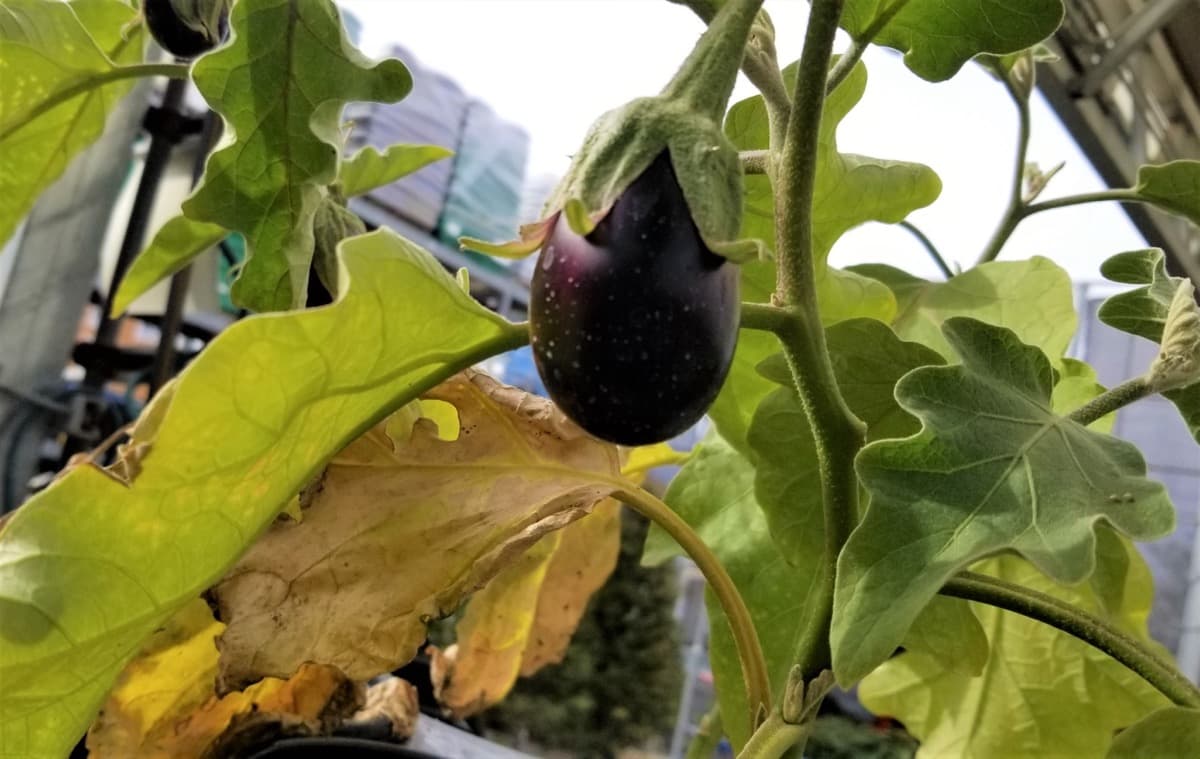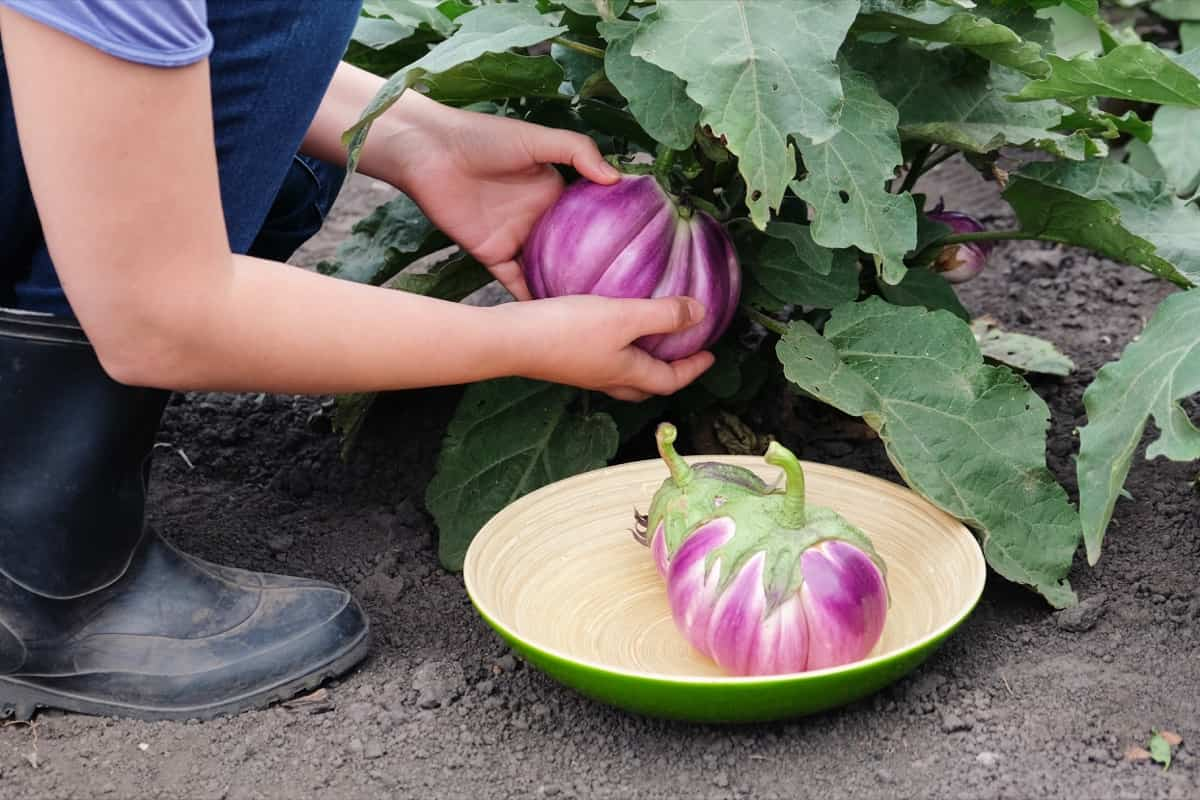One variety of Brinjal that is particularly unique and striking is the round violet/black variety. Here’s a how-to for planting and caring for your brinjal crop. Below we learn how to grow round violet/black Brinjal at home with and without seeds, how to plant brinjal seeds, and a step-by-step guide to grow violet/black round Brinjal.

How to grow Round Violet/Black Brinjal at home
How to plant round violet/black brinjal step by step?
Location and soil: Because brinjal plants need a warm, sunny environment to flourish, it is advisable to locate them there. Planting brinjals in a greenhouse or under plastic coverings can help warm the soil in a chilly environment. It’s important that the soil has good drainage, is rich in organic matter, and supports plant growth. You should also add a slow-release fertilizer into the soil to give your plants nutrients during the growing season.
Planting and care: Brinjal seeds can be started indoors in pots, or purchase seedlings from a local garden center. When starting seeds indoors, plant them in pots filled with a well-draining soil mixture and place them in a warm, sunny location. The seeds should sprout in approximately two to three weeks if the soil is wet but not soaked. Seedlings may be transplanted when they reach 4 to 6 inches.
Give your brinjal plants room to flourish by putting them at a distance of around two to three feet apart in the garden. To keep your brinjal plants healthy, water them consistently, but avoid drowning them or letting the soil gets saturated. Apply a balanced fertilizer once every two to three weeks throughout the growing season to ensure the best possible growth of your brinjal plants.
Pruning and training: Brinjal plants grow tall and can become quite leggy, so it’s important to prune and train them to promote bushier growth and to make harvesting the fruit easier. To prune your brinjal plants, remove any shoots that emerge from the base of the plant and any shoots that grow from the side stems.
This will encourage the plant to focus its energy on producing fruit rather than on producing foliage. You can also train your brinjal plants to grow in a specific shape, such as a teepee or a trellis, by tying the stems to supports. This will keep the plants off the ground and make it easier to harvest the fruit.
Pests and diseases: Brinjal plants are susceptible to various pests and diseases, so it’s important to be vigilant in monitoring your plants and taking action if you notice any signs of trouble. Some common pests that affect brinjals include aphids, whiteflies, and spider mites. To control these pests, you can use insecticidal soap or a solution of neem oil and water.
In case you missed it: How to Grow Long Green/Violet Brinjal at Home: A Step-by-Step Process

Another common issue with brinjal plants is fungal diseases, such as verticillium wilt or Alternaria solani. To prevent these diseases, plant your brinjals in well-drained soil, avoid overhead watering, and provide plenty of air circulation around the plants. Treating your plants with a fungicide can be necessary if you see any indications of diseases.
Harvesting your brinjals: When you’ve decided to start harvesting eggplant, ensure you’re protected from the plant’s prickles by wearing gloves and long sleeves. It’s important to be careful while picking eggplants since the fruit readily bruises. When gathering eggplants, snip off a little section of the stem just above where the calyx (cap) meets the fruit. You could use a pair of pruners or a sharp knife. While picking ripe eggplants might take several days to a few weeks, doing so often results in a larger crop.
Frequently asked questions about growing Brinjal
How long do Eggplants/Brinjal live?
Most eggplant varieties are planted as annuals because of their short lifespan. Once the eggplants have been picked, the plants often die. In ideal conditions, an eggplant plant will survive for three years if planted as a perennial. Even in perfect conditions, the lifetime of a healthy eggplant is very brief. Therefore you shouldn’t plant them if you’re looking for a long-lived plant. Tomato plants are only one member of the nightshade family that might surprise you by surviving for many years.
How can I make my Brinjal grow faster?
Soil that is both rich and well-drained is ideal. Even while they can be grown from seeds placed directly in the ground, their slow fruiting period means that starting them in trays four weeks ahead of planting time and then planting the seeds when the earth warms up is a more efficient use of your time. The germination period for seeds is two to three weeks. Plant seedlings at a distance of 45-60 cm (1.5-2 ft) apart. Transplanting requires special attention so as not to impede the plant’s development. After three to four months, the plant will produce fruit.
Which month is best for growing Brinjal?
Sowing occurs twice a year in the plants of Northern India, once in June–July for the autumn harvest and once in November–December for the spring–summer crop month of April. The best time to plant Brinjal in South India is between July and August. However, it can be cultivated year-round there. Seeds are sown in the hills between March and April, and young seedlings are transplanted in May.
In case you missed it: How to Grow Hydroponic Tomatoes: Indoors, Yield, Problems, and Solutions

Do Eggplants need a lot of water?
Deep, infrequent watering of 1–2 inches per week is ideal for eggplant. If you can switch to drip watering. Mulching the area surrounding the plant effectively prevents water loss and limits the spread of weeds. Applying water via irrigation helps the water penetrate the soil. Root rot or stiff, leathery fruit might result from inconsistent irrigation.
Conclusion
Since it is grown during the warm season, brBrinjals easily damaged by cold. Fruits deteriorate due to low temperatures throughout the chilly season. For optimal brinjal growth, a lengthy, hot growing season is ideal. Inadequate yield might be expected because of the cool nights and short summers. Maximum development and productivity are attained at mean daily temperatures of 13 to 21 degrees Celsius. Successful germination of brinjal seeds occurs at 25 degrees Celsius. With the help of the above information, you can plant your brinjal plant and reap its benefits.
- Feed Your Flock for Less: Top 10 Tips to Save on Chicken Feed
- Ultimate Guide to Ossabaw Island Hog: Breeding, Raising, Diet, and Care
- Hatching Answers: The Top 10 Reasons Your Chickens Aren’t Laying Eggs
- Eggs and Economics: Breaking Down the Cost of Raising Backyard Chickens
- Defend Your Greens: Proven Methods to Keep Iguanas Out of Your Garden
- Ultimate Guide to Cinnamon Queen Chicken: A Comprehensive Guide for Beginners
- Ultimate Guide to California Tan Chicken: Breeding, Raising, Diet, Egg-Production and Care
- Ultimate Guide to Marsh Daisy Chicken: Breeding, Raising, Diet, and Care
- 10 Types of Chicken Farming Businesses You Can Start for Profits